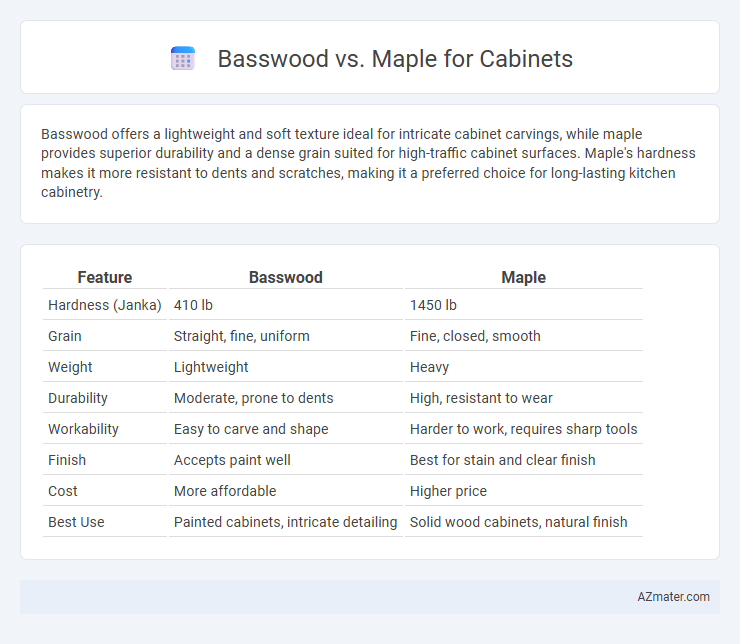Basswood offers a lightweight and soft texture ideal for intricate cabinet carvings, while maple provides superior durability and a dense grain suited for high-traffic cabinet surfaces. Maple's hardness makes it more resistant to dents and scratches, making it a preferred choice for long-lasting kitchen cabinetry.
Table of Comparison
| Feature | Basswood | Maple |
|---|---|---|
| Hardness (Janka) | 410 lb | 1450 lb |
| Grain | Straight, fine, uniform | Fine, closed, smooth |
| Weight | Lightweight | Heavy |
| Durability | Moderate, prone to dents | High, resistant to wear |
| Workability | Easy to carve and shape | Harder to work, requires sharp tools |
| Finish | Accepts paint well | Best for stain and clear finish |
| Cost | More affordable | Higher price |
| Best Use | Painted cabinets, intricate detailing | Solid wood cabinets, natural finish |
Overview: Basswood vs Maple for Cabinets
Basswood and maple are popular choices for cabinet construction, offering distinct characteristics that influence durability and appearance. Basswood features a soft, lightweight texture with a fine, even grain ideal for intricate carving and painting, while maple provides a harder, denser surface known for its strength, smooth finish, and resistance to wear. Choosing between basswood and maple depends on the desired cabinet style, usage, and budget, with maple favored for high-traffic areas and basswood preferred for detailed design work.
Wood Characteristics: Basswood and Maple
Basswood is a lightweight, fine-grained hardwood with a pale, creamy color that is easy to carve and shape, making it ideal for detailed cabinetry and painted finishes. Maple is a dense, hard wood known for its strength and durability, featuring a smooth texture with a light, creamy color and subtle grain patterns, suitable for high-traffic cabinetry. Both woods resist warping, but maple offers superior hardness and wear resistance compared to the softer basswood.
Appearance and Grain Patterns Comparison
Basswood cabinets exhibit a fine, uniform grain with a pale, creamy color that provides a smooth and subtle appearance ideal for painted finishes. Maple features a tighter, more pronounced grain pattern with light to medium tones ranging from creamy white to reddish-brown, offering a natural warmth and visual interest. The straight grain of basswood contrasts with the slightly wavy or curly grain often found in maple, influencing the overall texture and depth of cabinetry surfaces.
Strength and Durability: Which is Superior?
Basswood offers moderate strength and durability, making it suitable for lightweight cabinetry but less resistant to impact and wear compared to harder woods. Maple is known for its exceptional hardness and durability, providing superior resistance to dents, scratches, and heavy use, ideal for high-traffic cabinets. When prioritizing strength and long-term durability, maple surpasses basswood as the preferred choice for cabinet construction.
Workability and Machining Differences
Basswood offers superior workability compared to maple due to its softer texture and fine, even grain, making it easier to cut, carve, and shape without splintering. Maple, being a harder and denser hardwood, requires more effort in machining but provides excellent durability and a smooth finish when properly treated. The machining differences highlight basswood's suitability for intricate details and hand tools, while maple is preferred for robust cabinetry requiring high resistance to wear.
Finishing Capabilities: Staining and Painting
Basswood offers excellent finishing capabilities with a smooth, fine grain that readily accepts paint, making it ideal for detailed cabinetry requiring an even, uniform finish. Maple, characterized by its dense, closed grain, stains well but often requires a pre-conditioner to avoid blotchiness and achieve a consistent tone, especially with darker stains. Both woods provide durable surfaces, but basswood's superior paint adhesion contrasts with maple's natural beauty enhanced through careful staining techniques.
Cost Comparison: Basswood vs Maple
Basswood cabinets typically cost less than maple due to the wood's softer texture and faster growth rate, making it an economical choice for budget-conscious projects. Maple offers greater durability and a denser grain, resulting in a higher price point but increased longevity and resistance to dents and scratches. Evaluating cost per board foot, basswood ranges around $3 to $5, while maple averages $6 to $10, reflecting the premium quality and finish versatility of maple cabinetry.
Best Uses: Suitability for Cabinet Styles
Basswood offers a soft, fine-grained texture ideal for painted cabinet styles, providing a smooth surface that minimizes grain visibility and facilitates intricate carvings. Maple is a dense, hard wood prized for its durability and natural beauty, making it best suited for stained or clear-coated cabinets that highlight its subtle grain patterns in modern or traditional designs. Both woods excel in cabinetry but cater to different aesthetic choices: basswood for detailed, painted finishes and maple for robust, natural wood appearances.
Environmental Impact and Sustainability
Basswood cabinets offer a more sustainable option due to the tree's rapid growth rate and widespread availability, resulting in lower environmental impact from harvesting. Maple, while denser and more durable, grows slower and requires more resources, which can increase its ecological footprint. Choosing basswood supports sustainable forestry practices and reduces carbon emissions linked to wood production and transportation.
Final Verdict: Choosing the Right Wood for Your Cabinets
Basswood offers a softer texture and excellent workability, making it ideal for intricate cabinet details and painted finishes, while maple provides superior durability and a harder surface suited for high-traffic kitchen environments. Choosing between basswood and maple depends on the balance between aesthetic preference and long-term wear resistance, with maple favored for heavy-use areas and basswood preferred for customizable, smooth finishes. For cabinets requiring strong resistance to dents and scratches, maple is the optimal choice, whereas basswood suits designs emphasizing fine craftsmanship and a pristine painted look.

Infographic: Basswood vs Maple for Cabinet
 azmater.com
azmater.com